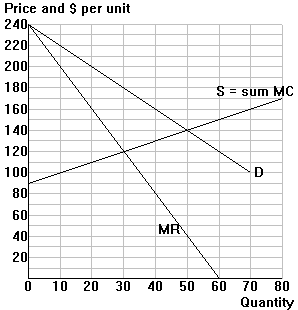The diagram to the right initially represents
market demand and supply for a competitive industry. The supply curve represents the
horizontal sum of the individual firms' marginal cost curves. (Ignore the MR curve for
now.)
|
 |
||||||||||||||||||||||||||||||||
|
Monday, April 08, 2013 |
Monopoly and output (allocative) efficiency
The diagram to the right initially represents
market demand and supply for a competitive industry. The supply curve represents the
horizontal sum of the individual firms' marginal cost curves. (Ignore the MR curve for
now.)
|
 |
||||||||||||||||||||||||||||||||
| 2. | a. | What is the value of the elasticity of demand at the monopoly output and price level: ________ |
| b. | Does the monopoly charge a price that satisfies the monopoly
markup rule? How can you tell?
|
|
| Part 2: Regulated monopoly: Now suppose that there is a price ceiling set for the monopoly at a price of $160. The price ceiling changes the price and marginal revenue situation faced by the monopolist. | |||||||||||
| 3. | a. | Complete the following table: | |||||||||
|
|||||||||||
| b. | Add the price ceiling to your diagram, and highlight the new MR curve faced by the monopolist. | |
| c. | Given the price ceiling: --How much output would the monopolist choose to maximize its profits? ______ --In the diagram (1) indicate the new output level and (2) use the pattern "\\\" to shade in the new welfare loss. |
|
| d. | What output level would the monopolist choose with a price
ceiling of $130? ______ --Is the welfare loss >, <, or = the welfare loss with the price ceiling of $160? ______ |
|
| e. | What level of price ceiling would achieve output efficiency? ______ | |